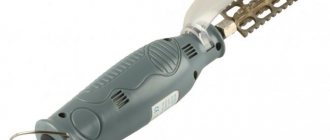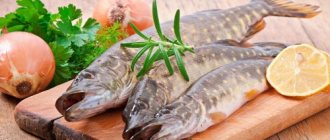The primary filleting of carp consists of cleaning the scales, gutting through a cut in the abdomen, and removing the vertebral and rib bones. Full cutting involves removing the skin from the carp fillet. Gutting for stuffing large fish can be done through a cut in the back to the abdominal cavity. Below are methods for cleaning scales, gutting, cutting large and medium-sized carp to obtain fillet steaks without skin and bones. After the initial stages of cutting, the carp can be baked whole and stuffed. Fillets in the form of steaks are more often used to prepare fried fish.
Fried carp “Boneless”
Who among us doesn’t love fried carp – a fish with perfect taste, quite healthy and juicy? However, carp dishes cannot be called overly popular.
The culprit is the notorious small bones, which spoil the entire impression of river fish. Okay, ribs - it’s hard to “miss” them. But is there really no effective way to get rid of the thin bones that force you to focus not on eating, but on extracting inedible components. Of course there is! And now we will tell you how to fry carp so that there are no small bones.
Ingredients:
- fresh carp – 1 carcass (best weight – from 1 to 1.5 kg);
- salt - to taste;
- flour for breading – 2 tbsp;
- vegetable oil for frying (preferably refined).
To process and prepare carp, you do not need any non-standard equipment: just a knife, kitchen scissors, a frying pan and a board for cutting fish.
Features and value of carp
Carp is an artificially bred species of fish, the ancestor of which is the carp. The word "carp" comes from the Greek language and is translated as fruit. And for good reason: one female produces up to 1.5 million eggs. The Chinese were the first to breed domesticated carp. Historians believe that this fish began to be used as food back in 1000 BC. e. Carp dishes became a favorite treat for Chinese emperors. Later, fish began to be bred in other Asian countries and Europe.
Carp meat has great benefits for the body. It is very tender and sweetish in taste. The fat content of fish muscle tissue is lower than that of lean beef, which is important for people on a low-fat diet, as well as for children and athletes. Carp is a source of many important nutrients, proteins and omega-3 fatty acids. These unsaturated acids have a positive effect on cardiac function and help prevent cardiovascular diseases. Another feature of carp is its ease of digestibility, due to the special structure of muscle fibers.
It takes three or four years to grow carp in artificial reservoirs. Three-year-old individuals reach a weight of about 2 kg, and four-year-old individuals weigh more than 2.5 kg.
Carp is a domesticated form of carp
Varieties of carp - gallery
Naked carp have absolutely no scales
A special feature of the mirror carp is the arrangement of large shiny scales along the back.
The body of the common carp is completely covered with medium-sized scales
Tips for choosing quality fish
- Fresh carp is easier to clean. If you buy fish in a store or market, try to take it from an aquarium. You can kill it with a strong blow to the head at a point located slightly above eye level, or simply by cutting off the head (if you are not going to bake the whole carp). There is a more humane way to kill fish - put it in the freezer for an hour and it will fall asleep.
- If you do not have the opportunity to buy live fish, it is better to choose fresh chilled fish, since frozen fish loses a large amount of minerals when thawing. When purchasing fresh fish, choose a specimen with the head on. This is the only way you can be sure of its freshness.
- Before buying, look into the eyes of the fish: fresh ones should be bright, slightly moist and convex.
- Be sure to inspect the gills and choose a specimen with clean, bright, and red gills.
- The body of fresh fish is quite elastic, without white coating or dried crusts, and the tail should hang freely from the palm.
- When purchasing frozen carp, pay attention to its glaze. If the fish was properly frozen and stored under all necessary conditions, the glaze on it should be smooth, without cracks. If the carp was frozen using dry freezing, then the carcass should be smooth and hard, without ice.
It is best to thaw frozen fish in water at room temperature. To reduce the loss of minerals during thawing, add table salt to the water (7-10 g per 1 liter of water).
The eyes of fresh fish should be bulging and slightly moist, and the carcass should be elastic, without white coating or dried crusts.
How to fry carp
There will be no intrigue: we will reveal the secret of cooking carp without small bones at the very beginning of this recipe. Thin bones penetrate only the upper part of the carcass - the fish's back (in the lower part there are large bones - ribs). Therefore, you need to act precisely in this area - on the back of the fish. Place the gutted carp on a kitchen board and, using a sharp knife, make parallel cuts (every 7-10 mm) along the entire back, starting from the tail and ending with the head. Do the same on the other side of the fish carcass. These cuts will crush the small seeds. And then, during heat treatment, the shortened pieces of bones will soften and seem to evaporate from the carp.
It is convenient to make cuts while holding the fish by the head or tail with one hand, so you should remove inedible parts of the carp only after making them. Use scissors to cut off the fins and tail, and use a knife to cut off the fish's head.
Cut the carcass into portions: from a small carp you can make 4 servings, and from larger fish - 6 or more.
Place the frying pan on the fire and pour refined oil onto its bottom. While it is heating, pour flour into a plate. Rub each piece of fish with salt and then roll in flour. At the same time, there is no need to try to ensure that the flour gets into the hollows in the cuts made: if it is there, it will not fry in the pan, but will turn into a thick mush. Therefore, it is best to sprinkle flour only on the outer sides of the portion pieces.
If the oil is already hot, place the pieces of carp in flour in the pan.
Fry the fish until golden brown on one side, then on the opposite side, and then on the remaining sides that require frying.
That's all: carp without small bones is ready! Thanks to the secret we told you about, the small bones evaporated so much that they became invisible.
There are some bone “details” left in the back, but only the hardest ones and those that are hard to miss.
Source
Removing scales
At this stage, it is most difficult to clean carp, so you must know how to properly remove scales from the fish. It is best to use a special fish cleaning device for this. They have sharp serrations that easily separate even the toughest scales. Such devices are sold in stores or can be made independently.
During cleaning, the scales fly in different directions. To avoid this, housewives recommend cleaning in a basin of water so that the scales remain in it. Either place the fish inside the bag and put your hands in there to clean it inside, so all the cleaning will remain there.
Advice! To more easily and effortlessly separate the scales from the fish, it must be placed in boiling water. The time required to achieve the desired effect is no more than 1 minute, otherwise the carp will be cooked.
Scales from large fresh carp can be removed with a knife. To do this, place the fish on a cutting board and, pressing down on the tail, clean the carcass with sharp movements. But it is in this case that the housewife finds herself in a situation where, after she has cleaned the carp, she needs to clean out the kitchen. Therefore, the above measures should be taken.
Recipe for baked carp in the oven with vegetables
The carp must be scaled, the head cut off, gutted, and washed under cold water. Squeeze the juice of one lemon and marinate the carp in it for 15-20 minutes. While the fish is marinating, prepare a cast-iron dish or baking sheet in which you will bake the fish, greasing it well with vegetable oil. The onion should be cut into rings, grate the cheese on a coarse grater. Mix wheat flour with fish spices, dill and vegetable oil until a thick paste forms. If the seasoning does not contain salt, add to taste. Divide the prepared mixture equally. Spread one part in an even layer over the bottom of the baking dish. In this case, the vegetable oil should completely cover the pulp. Place the onion rings on top in a thick, even layer to cover the flour base. Cut the second lemon that is left into even slices and place it on top of the onion rings. All this will give the carp an additional appetizing aroma.
Turn on the oven to preheat. The carp has already been marinated and has changed color a little. Now you need to rub it on both sides with sour cream, which must first be mixed with sunflower oil in a ratio of 1:3. Place the cooked fish on a baking sheet with a lemon-onion bed. Gently brush the top of the fish and the fragrant pillow with the remaining flour mixture. Wash the potatoes, peel and cut into slices no more than 3mm thick. Place in an even layer on top of the fish. Place the dish in the oven. The carp should cook for 30-40 minutes. At the same time, monitor the process of cooking fish from time to time. When the boiling juice begins to release, pour it over the carp several times. 10 minutes before the end of cooking, sprinkle generously with grated cheese.
Preparing fresh fish
Carp lives in fresh water bodies; most often this fish ends up on the table from a store or as a fisherman’s catch. If it was caught with bait, then the latter needs to be removed from the throat; this can be done by directing a stream of water there, which will wash away all the excess. You also need to remove the gills from the head, where bacteria begin to multiply first. All this is necessary if the preparation requires the presence of a head, otherwise it can simply be cut off later.
The carcass must be thoroughly washed to remove silt and the slimy coating that protects the scales. To do this, simply rinse the carp under running water. It is also worth cutting off the fins first so that they do not interfere when the time comes to clean the carp from scales. They can easily hurt you.
How to cut carp
Having bought live fish, do not refuse the offer to clean it, but it is better to gut it yourself at home:
- First you need to remove the dorsal fin, making shallow cuts on both sides along its entire length, then you need to pull the fin, wrapping it in a towel so as not to cut yourself, in the direction from the tail to the head;
- Next, from head to tail, make a cut in the abdomen, carefully remove the liver and gall bladder (if it is torn, rub the places where the bile got in with salt or cut them out);
- Remove the remaining entrails, gills and eyes of the fish; the film covering the vertebral bone must be cut lengthwise;
- Rinse it with cold running water and then cut the fish depending on the cooking method.
How to clean carp from scales
If it is not possible to clean the carp right away in the store, then do not despair, you can easily do it yourself. Don’t be scared by the old grandfather’s methods when they cleaned it with a knife against scales and the whole kitchen was dirty. There is a simple, proven way to clean carp from scales.
- To do this, place the fish in a deep cup and pour boiling water over it for 30 seconds.
- Pour out the hot water and place the fish under running cold water so that it cools and does not cook from boiling water.
- Next, you don’t have to take the fish out of the cup of cold water, but by placing your hands in the water and running your fingers against the scales, it will easily separate.
- If the fish is large and the scales are very thick and difficult to separate, then you can pour boiling water again for 10-20 seconds, again under cold water. Now the scales will definitely come off easily.
- You can also help yourself separate the scales with a knife, but do it carefully so as not to cut the already steamed skin of the fish.
And now for the most interesting part:
How to cut up carp and get rid of small bones?
In China, the homeland of carp, its fillet, having been cleared of large bones, is simply ground into minced meat, and during the cooking process, the ground small bones soften and partially dissolve.
If the fish will be cooked whole, then even in this case you can deal with small bones: for this, before frying, stewing or baking, as well as steaming, deep cuts are made on the fish carcass from the back along its entire length, and they are made crosswise - the more frequent cuts you make, the more small seeds will be crushed and softened during the heat treatment.
In addition, this technique allows the fish meat to be better saturated with seasonings and spices and cook faster.
The following method for filleting carp will also help get rid of small bones.
How to fillet carp
- cut off the head
- cut the fish in half lengthwise into two halves along the ridge,
- cut off the ridge, fin and small bones adjacent to it,
- carefully cut out the rib bones in one layer,
- use your fingers to feel the groove with sharp bones in the fillet, move 5 mm to the left from them and cut the fillet to the skin, holding the knife at an angle of 45 degrees,
- do the same, stepping back from those bones 5mm to the right,
- tear off the strip with bones from the skin,
- also remove small bones in the tail part of the fish.
As you can see, if you are willing to take the time to cut up the carp and remove the bones, then turning a bony fish into a tender fillet is quite possible.
Bony or not
Assessing how bony the carp’s skeleton is, it is worth highlighting the following features of this fish:
- A powerful ridge runs from head to tail.
- The rib bones are quite large.
- Also, the carcass contains a lot of small bones, which can spoil all the positive sensations from eating the dish.
Therefore, given that it is desirable to get carp without bones, before you start preparing this or that recipe, let’s figure out how to fillet this fish.
To prevent this process from taking a lot of time and effort, you should prepare the following basic tools and additional accessories:
- A sharp knife with a fairly long blade. It is desirable that it be narrow and flexible so that it can be placed comfortably between muscle fibers and bones. Please note that its length must correspond to the width of the body - otherwise it will be inconvenient to work.
- Plastic cutting board. You should not choose wooden options, as they are not hygienic when cutting raw fish or meat.
- Additionally, it is worth preparing convenient tweezers, which can easily and quickly remove small bones from fish.
The best carp dishes
There are also special recipes for cooking carp, based on the fact that this fish contains a lot of small bones; one of the most famous among such carp dishes is Chinese.
- 1 fish weighing about 1.2 kg,
- corn starch,
- vegetable oil,
- a handful of pine nuts,
- fresh green peas,
Ingredients for the sauce:
- 6 tbsp each cold water and ketchup/tomato paste,
- 2-3 tbsp. Sahara,
- 1-2 tbsp. rice vinegar,
- 1 cm fresh ginger root,
- 1 leek white part,
- 1-2 tsp. corn starch,
- salt.
How to remove fins from fish?
Remove the scales with a knife or special tool, starting from the tail and moving towards the head. Cut off the dorsal fin with scissors. If desired, you can remove the dorsal and anal fins by cutting them on both sides with a sharp knife. Then pull the fin and remove it.
Interesting materials:
How to thank guests at a wedding? How to thank for a surprise? How to fix a zipper with a fork? How to fix a broken zipper? How to fix a chain on a mountain bike? How to clean white leather loafers? How to clean jewelry so it shines? How to peel shrimp so that the tail remains? How to clean a raccoon fur collar? How to clean a microwave oven with baking soda?
Royal fried carp
- 700 g fish fillet,
- 3 glasses of milk,
- 2 eggs,
- 4 tbsp. vegetable oil,
- 2 tbsp each flour and breadcrumbs,
- salt.
How to cook fried carp
Rinse the fillet, cut it into portions, pour milk and leave for half an hour.
Salt the flour, roll the fillet pieces in it, dip them immediately into the beaten egg, and bread them in breadcrumbs. Fry the fillet on both sides until browned for 15 minutes.
It would seem that the name is Royal Fried Carp, but in fact it is such a simple method of preparation.
However, this often happens with this fish - after all, it is really a very tasty fish that is difficult to spoil. Having learned to cope with the main problem of carp - the abundance of bones, you will be able to prepare the most appetizing dishes from this wonderful fish.
- To prepare carp fillets with sauce or cutlets with fillets, the rib bones are cut off, but for cutlets, as well as rolls, you can prepare the carp differently - gut it without peeling the scales, cut off the fillet on both sides, removing the skin and scales, and the remaining bones, heads, tails and fins are used to prepare broth (the gills must be removed).
- The fish is prepared either whole or cut into pieces weighing 100 g. If pieces of carp weigh more than 500 g, they should be placed in cold water, and smaller pieces should be placed in boiling water. It is believed that carp cooked in large pieces is tastier and juicier.
- When cooking fish, the water should be at a constant low simmer. Cook it whole with a weight of 1-1.5 kg for 50-60 minutes, in pieces of 100-150 g, 15-20 minutes of cooking is enough until ready.
- Small carp need to be cooked whole, large ones - in pieces; it is believed that it tastes better if you fry the fish with the skin.
- Fried carp will turn out tastier if, after cleaning and washing it, then cutting it, put it in 15-20 minutes of salted and peppered milk, after that it is breaded in flour and fried - best in a cast-iron frying pan with a lot of butter until golden brown and covered cover and cook until done.
- Fatty carp can be stuffed with leaner pike or pike perch.
- It goes very well with minced meat, best of all with pork, this combination is suitable for making cutlets and meatballs, the proportions of fish and minced meat are one to one.
Useful video: How to cook carp with herbs
Author of the article “How to cook carp”
- 500 grams of chilled carp,
- 3 tables. l. wheat flour,
- salt, pepper to taste,
- vegetable oil for frying.
How to get rid of odor
Like many other river or pond fish, carp have a not very pleasant smell of mud. In principle, properly cut and prepared carp smells less, but the smell still remains. Especially when the fish is cooked with scales.
The easiest way to reduce the smell of mud is to sprinkle the carcass with lemon juice before cooking.
You can remove the smell of mud by pre-soaking the fish in milk half an hour to an hour before cooking. You can also add aromatic herbs and spices there.
Removes odor and ordinary table vinegar. To do this, add a tablespoon of vinegar to one liter of cold water and soak the fish in it for 2 hours. After soaking, rinse well and dry with a paper towel.
If you don’t have time to get rid of the smell by soaking the fish, just sprinkle the already cooked fish with a large amount of fresh dill.
Cooking carp in a frying pan without bones
Wash the carp, remove scales, remove all the insides and rinse again. Wipe away drops of water with napkins. Cut off the fins from the fish, then make transverse cuts along the bones on the carp. We make frequent cuts so that the fish is better fried. It is the cuts that will help reduce the number of small seeds, as they will become softer during the frying process.
Salt and pepper the fish on all sides. We also season the inside of the belly. Salt and pepper are classic seasonings for any fish. But you can use dried rosemary or thyme, it all depends on your taste preferences.
Dip the carp in flour, shaking off the excess as it will burn in the pan.
Heat the vegetable oil in a frying pan and put the carp in it. Let's start frying over medium heat, the fish should simmer so that the oil is not too absorbed into the fish.
After frying the fish on one side, turn it over and fry on the other side. The carp should become ruddy and golden. Each side of the fish is fried for about 5-7 minutes.
The fried and tasty carp is ready, serve it immediately. It has a crispy crust and tender and juicy meat inside. Thanks to the cuts, the fish was perfectly fried, the small bones were softened, and only the large bones remained to be removed, which simplifies the task during lunch. Bon Appetite!
Source
Useful tips
When preparing the dish, it is recommended to adhere to the following tips:
- In order for the carp to be juicy, it must first be marinated in spices or lemon juice;
- For cooking, you should use large fish weighing more than 2 kilograms;
- in order for each bone to dissolve, before baking it is necessary to make small cuts on the surface on both sides;
- You can serve carp with a side dish of potatoes and cream sauce.
In order to properly cook carp, you need to strictly follow the recipe, namely its rules. Proper preparation, cutting, marinating and cooking will provide a tasty and aromatic treat, which can be an excellent option for both a family dinner and for treating guests on a holiday.
The option for preparing boneless carp will be discussed in the video:
source











